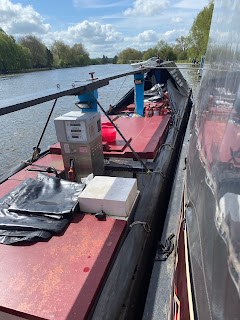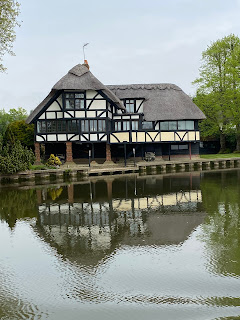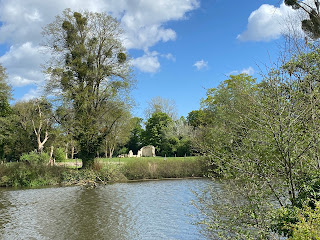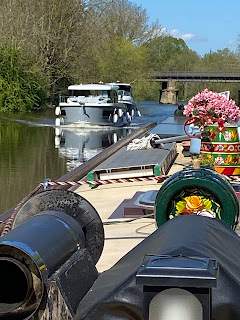Monday 14th April - Shepperton Village Moorings
We spent the morning having breakfast with Bea, playing cards and Bea playing on the tree swings. Lizzie and Lizzie joined us on the boat and we walked down to Shepperton Lock to have lunch at the Thames Court.
On the walk down we passed this pretty church, St Nicholas Church of Shepperton. There has been a church on this site since the 7th Century and the church has links with the novelist George Eliot and the hymn writer John Mason Neale.
Lizzie, Lizzie, Bea, myself and Toby after our lunch and before we walked back to the boat.
I spotted a dog grooming parlour in the Courtyard just opposite Shepperton Lock and a stroke of luck, she could groom Toby once she had finished the dog she as working on!
Toby beautifully cut and smelling gorgeous, he will be fine now until we get back to Worcester at the end of May. I am really pleased about that!
Tuesday 15th April - Shepperton Village Moorings to Egham Towpath Moorings
A rather cloudy and overcast day but dry so we decided to move on to Runnymede. Soon after leaving our mooring we passed this impressive building, Shepperton Manor House.
Here we are approaching Shepperton Lock and the river divides off to the left along the River Wey and then onto the Basingstoke Canal. Unfortunately the Basingstoke Canal is still closed due to lock repairs and then re watering which will take until at least the end of April so we have abandoned that plan and are continuing along the River Thames.
Today we shared all the locks with a wide beam from Shepperton Marina. ‘Berty’ is on its way to Windsor, so we shall leave it at Runnymede. All the locks were self-service so it was nice to have someone else to help operate the locks.
Coming through Staines the river frontage was adorned with rather splendid river cruisers. These are not unlike the ones we see when we are on holiday in Paxos, this one looks brand new!
The railway bridge in Staines is painted along the top with yellow sight lines to prevent swans flying into the solid grey girders according to Pearson’s Canal Guide. I wonder how likely that is?Finally passing under our last bridge and through the last lock and we moored up at Egham Towpath Moorings, just before Runnymede.
We were amazed at the number of aircraft taking off and landing at nearby Heathrow Airport and the noise level created. River fronted properties sell in excess of 1.6 million pounds, but how do you live with that amount of noise?
8 miles, 4 locks, 4hrs 30mins
Wednesday 16th April - Egham Towpath Moorings
We have decided to stay on our mooring as the wind is in excess of 20mph and we don’t like cruising in windy conditions. So once a sharp shower had passed the sun came out and there were brilliant blue skies and we took a walk along the river to Runnymede.
We came across a timeline on the stone slabs in front of this tree. Two parallel timelines are etched into the paving stones. One timeline follows the succession of kings and queens, while the other highlights key moments in the development of British democracy.
Across the river are the ruins of the Benedictine nunnery of Ankerwycke Priory. It was founded by Gilbert de Montfichet in around 1160 and was dissolved in 1536. The surviving standing remains and associated earthworks occupy the north bank of a loop of the River Thames.
In the distance on Cooper’s Hill is the Air Force Memorial. The Air Forces Memorial at Runnymede commemorates by name over 20,000 men and women of the air forces, who were lost in the Second World War during operations from bases in the United Kingdom and North and Western Europe, and who have no known graves. The memorial was designed by Sir Edward Maufe with sculpture by Vernon Hill. The engraved glass and painted ceilings were designed by John Hutton and the poem engraved on the gallery window was written by Paul H Scott.
After lunch at the cafe we found three willow women entitled The Last Survivors of an Ancient Race. The artist Sarah Holmes drew on ideas of freedom and people whose livelihoods are connected to the land and wove them from willow. Inside them are messages which have been contributed by law officials and young offenders.
The Jurors is a permanent artwork designed for this ancient landscape to mark 800 years since the sealing of Magna Carta in this place. It is formed of 12 bronze chairs, decorated with 24 panels of images and symbols relating to past and ongoing struggles for freedom, rule of law and equal rights. The Jurors is not a memorial, but rather an artwork which requires people to complete it.
Set in a symbolic acre of land donated to the United States of America by Queen Elizabeth II in 1965, this seven tonne block of Portland stone commemorates the life of President John F Kennedy following his tragic assassination.
Designed by Sir Geoffrey Jellicoe, it is maintained by the Kennedy Memorial Trust. Runnymede was felt to be the appropriate place due to the signing of the Magna Carta and its links to the American constitution.
Writ in Water is a large-scale architectural installation designed by artist Mark Wallinger, commissioned by the National Trust in association with arts producers Situations, which celebrates the enduring significance of Magna Carta. Set in the heart of this ancient landscape, Writ in Water reflects upon the founding principles of democracy and through a meeting of water, sky and light, offers a space for reflection and contemplation.
Thursday 17th April - Egham Towpath Moorings to Windsor Castle Moorings
After a very windy day yesterday we woke to a much calmer river and steam rising as the sun shone on the water. Quite an eerie spectacle really.
We decided to move on and aim for Windsor and hope we get a mooring.
We were chugging peacefully along until these two boats came tearing towards us. They had come under the bridge and were obviously racing each other, it caused a vast amount of wash! We were planning on putting on water at the lock but there was a boat moored on the water point, been there overnight according to the lockkeeper so we pressed on.
We eventually found a marina which was closed with an accessible water tap so we stopped there and filled up!
This lock keeper was very helpful, the lock was a side fill and he ensured we were moored in the best place in the lock so we didn’t get pushed around by the water too much. It was also the first time someone had helped with the ropes. We found a mooring on the Island and had a wander through the town and across the bridge to Eton.
It was very busy with loads of small hire boats buzzing up and down the river and the French Brothers trip boats flying past every 10 minutes. Too much for us and we decided to move on again tomorrow.
7 miles, 2 locks, 2hrs 42mins
Friday 18th April - Windsor to Maidenhead
It is hard to tell from this photo, but this is the first black swan we have seen this year, all by its self swimming down river. This popular ornamental species, introduced from Australia, is occasionally encountered in the wild, mostly as single individuals but sometimes in small groups. The species favours rivers and freshwater lakes.
We left Windsor before the boats starting moving again and headed towards Maidenhead. In the break in the trees is Windor Racecourse, which is renowned for its distinctive figure-of-eight track, making it one of only two such tracks in the UK. This unique layout adds an element of excitement and challenge to the races, with different sections of the course demanding varied strategies from both horses and jockeys.
Heading towards Bray we passed Bray Film Studios. With an 18th century former English country house at its heart, the studios have provided creative space for some of the greatest talent in film and music. Ridley Scott built and shot the miniatures for his Academy Award winning sci-fi thriller, Alien, at the studios in 1978 and a few years before, the cult classic, The Rocky Horror Picture Show, was brought to life here.
We shared a lock with this boat which is from Southampton. They did a 22 hour stint from Southampton, around the coast and in at the Thames Estuary. That sounds quite a trip!
On the riverside in Bray is The Hinds Head with The Fat Duck behind in the High Street, both are owned by Heston Blumenthal.
Coming into Maidenhead we pass under the railway bridge and then the main Maidenhead Bridge. Brunel’s railway bridge is the flattest and widest brick arch in the world and the gracious lines of Maidenhead Bridge date back to 1772, trains and horse drawn stage coaches in close proximity!
We went for a wander around Maidenhead, a trip down memory lane for Dave, he was Headmaster of Desborough Boys School in Maidenhead for nine years and also went there as a boy himself when it was Maidenhead Grammar School for Boys.
Here he is standing on the bridge over Boulter’s Lock.
5.5 miles, 2 locks, 2hrs 42mins
Saturday 19th April - Maidenhead to Cookham
Today we made an early start from our mooring to go through Boulter’s Lock and get to Cookham and secure a mooring for my birthday. When we got to the lock we were closely followed by 5 professional rowing boats going up to Cliveden Reach for training purposes and we were asked if they could go ahead of us. We agreed and by the time the lock was ready for us we were joined by 3 other cruisers.
We left the lock first closely followed by the cruisers in a convoy, leaving the last one to close the lock up behind them.
We were very quickly overtaken by all three boats as we trundled along to Cookham!
In the distance on the hill is Cliveden, now a hotel. Waldorf Astor married Nancy Langhorne in 1906 and received Cliveden as a wedding gift. Cliveden entered a new, glittering era as the venue for many parties and one of the centres of European political and literary life.In the 1930s the house parties were seen as having a more serious agenda and the group became known as the ‘Cliveden Set’. Following the ‘Profumo Affair’ the Astor family left Cliveden. Waldorf Astor had given Cliveden to the National Trust in 1942 and in 1966 the Trust took over the management of the estate, opening it to the public.
We found a lovely mooring in Cookham and moored up for the day. We went for a walk into Cookham and Dave bought me some flowers for my birthday tomorrow.
We stopped at the Tea Pot Tea Rooms and had a cream tea, delicious scones, clotted cream and homemade jam, very good indeed!This house has a blue plaque on the wall saying that it is the birth place of Stanley Spencer. An English painter, one of the most original figures in 20th-century British art. He lived for most of his life in his native village of Cookham, which played a large part in the imagery of his paintings. He said he wanted ‘to take the inmost of one's wishes, the most varied religious feelings…and to make it an ordinary fact of the street’, and he is best known for pictures in which he set biblical events in his own village; his visionary attitude has been compared to that of William Blake.

Stanley Spencer died in 1959 and during his lifetime he was awarded the CBE and knighted, and had been elected to the Royal Academy. Hilda remained the love of his life, and he continued to write to her even after her death. He was a most sociable character who has often been called eccentric and Patricia in her diaries even called him ‘mad’. As a character he was certainly different and unusual. The small man with twinkling eyes and shaggy grey hair (often wearing his pyjamas under his suit if it was cold) became a familiar sight wandering the lanes of Cookham pushing the old pram in which he carried his canvas and easel. He was also undoubtedly one of our greatest British artists. This is his gravestone in Cookham Churchyard.
3.25 miles, 2 locks, 2hrs 18mins
Sunday 20th April - Cookham
Happy Easter everyone! Today is my birthday so we are staying here in Cookham for the day.
We went for a walk along the river and Toby had great fun running in and out of the river and generally having a splashing time!
We stopped at The Bounty for some lunch and then continued across Cock Marsh and back into Cookham across Cookham Moor.
Later in the afternoon we saw this car being driven down the river, it did look a bit odd!
A lovely glass heart in the colours of the boat, a gift from Dave and it is hanging in the window beside the table, very pretty!










































































